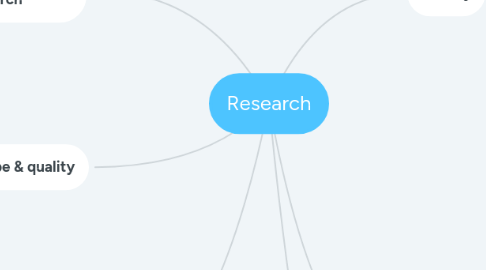
1. Understanding, interpreting and communicating research
1.1. the foundation upon which RD's provide information & advise
1.2. know its strengths & weaknesses, identifying sources of bias & communicating its results & implications
1.2.1. Potential Bias: funding sources, can come from all outlets & the people in them
1.3. guarantee that findings are definitive or conclusive
1.4. distinguish between editorials or commentaries & actual study findings
1.5. Critically evaluate research
1.5.1. find original research articles when possible
1.5.2. Source
1.5.2.1. was the study reputable
1.5.2.1.1. what type of study was conducted
1.5.2.2. peer reviewed journals
2. varies in type & quality
3. Contributors
3.1. The government
3.1.1. works to understand important health issues & ultimately sets public policy on these issues
3.2. Non Profits
3.2.1. provide research grants related to their mission; have limited budgets
3.3. Individual academic institutions
3.3.1. conduct the bulk of nutrition research
3.3.1.1. May hire external contract research orgs to conduct preclinical & clincal trials
3.4. Food and Beverage industry
3.4.1. ingredient suppliers, food manufacturers, retail, restaurants, commodity groups & trade associations
3.4.2. suport research for reasons beyond marketing intrests
3.4.3. how products are developed
3.4.4. satisfaction of regulatory requirements
3.4.5. label claim substantiation
4. History
4.1. 20th century; all about isolating & chemically defining essential micro nutrients & their role in deficiency
4.1.1. this lead to policy changes and guidelines. Like the fortification and 1st set of RDA's
4.2. 1950s-80's
4.2.1. Focus on dietary fat & sugar intake
4.2.1.1. led to the senate report of dietary goals for the US & their recommendation on lower cholesterol & low fat diets for all
4.2.1.1.1. 1980 this notion was challenged by the US National Academy of sciences of Food & Nutrition
4.2.2. 1975 science disproves that their is a "protein gap" but rather the problem is overall quantity of food in the diet
4.2.3. 1980: dietary guidelines for Americans was published but did not use the best research & followed single nutrient focus/deficiency disease model
4.2.4. Micro nutrient targets:iron, vitamin A & Iodine
4.3. 90's-present
4.3.1. Evidence debates, diet patterns, the double burden
4.3.1.1. most important scientific development- design & completion of multiple, observational, large nutrition studies, including prospective observational cohorts
4.3.2. focus shift to dietary patterns rather than single nutrient
4.3.3. Clinical trials
4.3.3.1. helps answer specific targeted questions about high risk populations & disease
4.3.4. Nutrigenomics
4.3.4.1. looking at how genes affect health and disease and if early dietary interventions can help
4.4. Future
4.4.1. building evidence for multifaceted effects of different foods, processing methods, diet patterns being the new focus of nutrition research
4.4.1.1. Includes: optimal dietary composition to reduce weight gain & obesity; pre & pro biotic interactions; gut microbiota, effects of specific FA's, flavonoids & other bio actives, personalized nutrition & the powerful influences on our society and the social status of nutritional disease disparities
5. drives policy
6. Nutrition Research
6.1. embraces many disciplines; math, physics, chemistry, biochem, physiology, physical & mental development, disease prevention, clinical care, food production, food processing, food marketing, consumer behavior & choice, social relations, micro & ,macro economics, policy & planning
6.2. demand led
6.3. integrative & complex
6.3.1. due to interaction of internal & external systems, which are complex
6.4. requires focus on particular aspects of complex interactions
6.5. The success of research over the past 100 years has been to gain a better determination of the body’s needs under specific circumstances, and the requirements for individual nutrients and their relative proportions.
6.6. needs to provide a base of evidence to improve health promotion, disease prevention and clinical care, drawing on understanding from science to improve practice
6.6.1. need to understand: . The three systems within the social systems that embrace the social determinants of health; the lifestyle systems that contribute and determine individual behaviors and how they relate to health; and the whole-body human biological system, its regulation and integration

